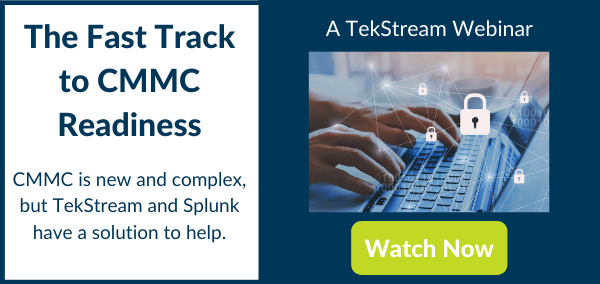CMMC Response – Managing Security & Compliance Alerts & Response for Maturity Levels 4 and 5
The Cybersecurity Maturity Model Certification (CMMC) is here and staying. There are increased complexities that come with the new compliance model as compared to NIST 800-171, and organizations have to be prepared to not only navigate the new process but also reach the level that makes the most sense for them.
Level 3 (Good Cyber Hygiene, 130 Practices, NIST SP 800-171 + New Practices) is the most common compliance threshold that Defense Industrial Base (DIB) contractors are seeking out. However, there can be significant value in increasing to a Level 4 and eventually a Level 5, especially if you’re leveraging the Splunk for CMMC Solution.
Thanks to the DoD’s “allowable costs” model (where you can defray costs of becoming CMMC compliant back to the DoD), reaching Level 4 offers significant value at no expense to your organization.
Even if you’re not currently pursuing contracts that mandate Level 4 compliance, by using TekStream and Splunk’s combined CMMC solution to reach Level 4, you end up with:
- – A winning differentiator against the competition when bidding on Level 3 (and below) contracts
- – The option to bid on Level 4 contracts worth considerably more money
- – Automating security tasks with Splunk ES & Phantom
- – Excellent security posture with Splunk ES & Phantom
And all of these benefits fall under the “allowable costs” umbrella.
The case for reaching Level 4 is clear, but there are definitely complexities as you move up the maturity model. For this blog, we want to zero in on a specific complexity — the alert and response set up needed to be at Level 4 or 5 and how a SOAR solution like Splunk Phantom can get you there.
How Does Splunk Phantom Factor into Levels 4 and 5?
Level 4 is 26 practices above Level 3 and 15 practices below Level 5. Level 4 focuses primarily on protecting CUI and security practices that surround the detection and response capabilities of an organization. Level 5 is centered on standardizing process implementation and has additional practices to enhance the cybersecurity capabilities of the organization.
Both Level 4 and Level 5 are considered proactive, and 5 is even considered advanced/progressive.
Alert and incident response are foundational to Levels 4 and 5, and Splunk Phantom is a SOAR (Security Orchestration, Automation, and Response) tool that helps DIB contractors focus on automating the alert process and responding as necessary.
You can think about Splunk Phantom in three parts:
- SOC Automation: Phantom gives teams the power to execute automated actions across their security infrastructure in seconds, rather than the hours+ it would take manually. Teams can codify workflows into Phantom’s automated playbooks using the visual editor or the integrated Python development environment.
- Orchestration: Phantom connects existing security tools to help them work better together, unifying the defense strategy.
- Incident Response: Phantom’s automated detection, investigation, and response capabilities mean that teams can reduce malware dwell time, execute response actions at machine speed, and lower their overall mean time to resolve (MTTR).
The above features of Phantom allow contractors to home in on their ability to respond to incidents.
By using Phantom’s workbooks, you’re able to put playbooks into reusable templates, as well as divide and assign tasks among members and document operations and processes. You’re also able to build custom workbooks as well as use included industry-standard workbooks. This is particularly useful for Level 5 contractors as a focus of Level 5 is the standardization of your cybersecurity operations.
TekStream and Splunk’s CMMC Solution
With TekStream and Splunk’s CMMC Solution, our approach is to introduce as much automation as possible to the security & compliance alerts & response requirements of Levels 4 and 5.
Leveraging Splunk Phantom, we’re able to introduce important automation and workbook features to standardize processes, free up time, and make the process of handling, verifying, and testing incident responses significantly more manageable.
If you’d like to talk to someone from our team, fill out the form below.


